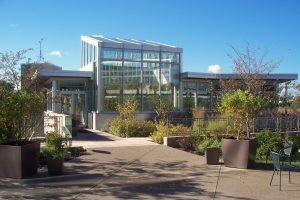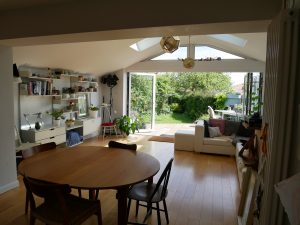
Biophilic design: Center for Sustainable Landscapes, Phipps Conservatory and Botanical Gardens. The natural connections seen in this building through glass walls and views of nature make it an excellent example of biophilic design. Occupants have nature in full view. It is also one of the greenest buildings in the world, generating all of its own energy and treating all water captured on site.
Image source: commons.wikimedia.org (Cbail19)
What is Biophilic Design?
Biophilia sits at the root of my approach to design and life, and is the founding concept of Chalk & Moss. So I wanted to explain more about this fascinating and important field of research.
The term biophilia means love of life or living things. The term was first used in 1964 by psychologist Erich Fromm, defining it as “the passionate love of life and all that is alive”. It was popularised by biologist Edward O Wilson in 1984, who in his book “Biophilia” refers to “an innate and genetically determined affinity of human beings with the natural world.”
Forest Bathing and the Benefits of Soil
Research in many fields of psychology supports this notion as a way to safeguard our wellbeing, with many psychologists re-introducing natural elements and activities to patients with great effect. Since the 1980s, Japan has been practicing the common healthcare concept of Shinrin-yoku or “forest bathing” (meaning “walking in the forest”). This has been shown to lower heart rate and blood pressure, reduce stress hormone production, boost the immune system, and improve overall feelings of wellbeing. A Japanese study looked into the level of the stress hormone salivary cortisol. It found this to be on average 13.4% lower after just 20 minutes of absorbing forest scenery compared to an urban setting.
The reason breathing in forest air feels so good is because wood and many plants secrete essential oils known as phytoncide, which improve immune system function. Dr Dorothy Matthews and Susan Jenks found that mice navigated their way through a maze twice as fast after being exposed to Mycobacterium vaccae. Mycobacterium vaccae is a natural soil bacterium that we inhale when spending time in nature. In 2006, a Danish study found creativity to be far higher in children who attended outdoor nurseries. 58% of children who were in close contact with nature invented new games, compared to 16% of children at indoor nurseries. Vitamin D from sunshine is of course also an important factor for lung health, moods and reduces the risk of certain diseases and fractures. These studies, and many others, can explain for why a countryside walk clears our head.
You can read more about forest bathing in this blog post.
Applying Nature Principles in Biophilic Design to Improve Health and Wellbeing
This nature based research and practice has extended to design and architecture, looking at the positive impact a natural connection has on our creativity, productivity, stress and overall health. This is biophilic design. Incorporating nature and natural elements in our workplaces, schools, hospitals and homes is an important way of helping us be and feel our best, and help us quickly recover when things go wrong.
Giants such as Google, Amazon and Apple have created fully biophilic offices. This aims to keep their staff creative, productive and happy long term. Working among greenery and with views that span the height of the buildings, workers can see each throughout the building. This connects them both to nature and co-workers in a supportive and open way. There are also ample opportunities to work and socialise outside on the campus grounds. These companies recognise that if the working environment incorporates natural colours, materials, sounds and light, then staff feel more valued and be ore loyal.
A report by Human Spaces found that natural light and greenery led to a 15% increase in staff wellbeing and creativity, and 6% increase in productivity over a three month period. This of course applies not only to the workplace. Studies in hospitals have found that patients recover quicker if they have access to natural views or art. Children are more receptive to learning if they are given a connection to nature in the classroom and, ideally, time learning outside.

In our home, we’ve brought the outside in. We have wooden floors that match the stone slabs outside, and allow lots of light in through bi-fold doors and four Velux windows. I love having plants all around the house. Many are herbs to add natural scents. I often work outside, surrounded by sounds, smells and sights. Photo by Anna Sjostrom Walton.
Biophilic Design can be Easy
Needless to say, using biophilic design principles in the home give the space a wonderful sense of calm and a restorative quality. Use large windows to blend the outside with the interior, taking in the greenery and light from outside. In cities, or where space or views are limited, you can easily bring nature inside with plants. Plants are not just a visual stimulant, but also help cleanse the air we breathe. Specific plants have different qualities. The purifying effect of Peace Lilies, for instance, make them a great addition to work spaces and classrooms where focus is key. Incorporating wood, stone and other natural materials and colours from nature help create a natural link. You can with great effect also incorporate shapes, images and artwork that mimic nature.
Time for a Breather
I have always worked in digital media, and can sense when it’s time for me to take a breather and head into the woods. I unwittingly used biophilic principles long before I’d heard of the term. Nature has always played a central role in how I spend time with my family inside and outside our home. Nature is central to making it a safe place of rest, fun, engagement, socialising and learning.
Our environments are becoming increasingly urban and technologically dependent. It’s vital that we balance this to keep that nurturing connection to nature safe.
Find inspiration in the Biophilic Design category on the blog, including this post about how I used these principles in my own home.
Sign up to the Chalk & Moss newsletter to get your free guide “Top 5 home decor tips for wellbeing” and a 10% off code for the online shop.
[mc4wp_form id=”131″]
